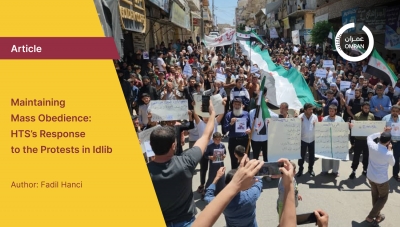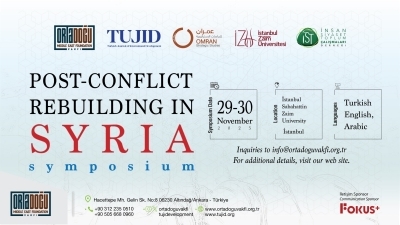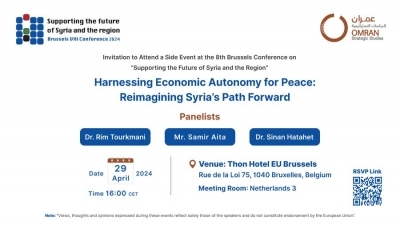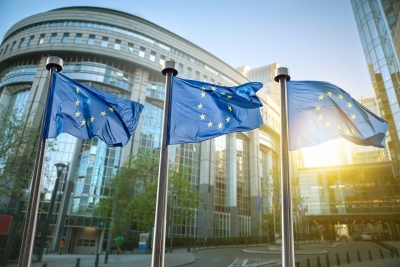Since early 2024, Hay’at Tahrir al-Sham (HTS) has been working to contain the civilian unrest in its controlled areas in Northwestern Syria, which was triggered by the internal crisis of the mid-2023. While HTS has considerable experience in managing internal power struggles, including defections, it has not faced such widespread popular protests since it has begun to acquire monopoly of governance in Idlib in 2017(1)
The interaction between HTS and the civilian populations in Idlib, has been characterized as a relationship between ruler and ruled, with HTS relying on mass obedience and modest support- similar to many hybrid insurgencies(2), This article elaborates on the grievances that triggered the protests challenging HTS’s ability to maintain mass obedience and how HTS employed a calibrated response to sustain it.
Old and New Grievances
The process of establishing governance and ensuring its monopoly in the hands of the Syrian Salvation Government (SSG) from November 2017(3)onwards has created local grievances that played, among other factors, a crucial role in fueling resentment toward the HTS. The authoritarian nature of HTS’s rule is quite reflected in its way of dismantling the local councils, the establishment of the “General Security Service” (GSS) and its use of detention and torture to intimidate opponents.
In 2023, local councils were dismantled in favor of the SSG’s centralized eight municipalities system(4), which operates under the SSG’s Ministry of Local Administration and Services. This move came after a long process of gradually cracking down on local councils, overcoming their resistance and their efforts to maintain their autonomy and slow down the HTS’s growing control over governance in Idlib.
HTS first brought local councils operating in its strongholds, as in the case of Harem, under its control either by directly overseeing them or by supervising phony elections to designate new councils following the establishment of the SSG. Then, after defeating the National Liberation Front (NLF) in 2019, HTS coerced the remaining local councils in previously NLF-controlled areas, such as Kafr Takharim and Jabal al-Zawiya, to submit to its authority.
HTS acknowledged that dismantling local councils had contributed to local resentment. Before the protests began, HTS’s leader al-Jawlani had rejected suggestions to reestablish local councils during meetings with local notables. However, the protests compelled HTS to compromise by forming a new committee in March 2024 (5), tasked with defining the rules and procedures for local council elections in HTS-controlled areas. Nonetheless, the effectiveness of these councils remains uncertain.
The General Security Service (GSS), established in mid-2020(6) as a security and intelligence apparatus for HTS, has played a key role in suppressing opponents during HTS's power consolidation, leading to widespread grievances. Tasked with enforcing regulations, conducting security operations, and managing detention facilities; the GSS has already developed a notorious reputation among local communities for its violent conduct and use of torture in its prisons. Common methods of torture include handcuffing, blindfolding, dragging, hanging detainees from the ceiling, and beating them with cables or hosepipes to extract confessions(7).
The GSS sparked even more outrage following the internal purge that began in August 2023(8). During this period, hundreds of HTS members were arrested on charges of espionage and subsequently subjected to severe mistreatment and torture. The widespread use of torture resembled the brutal tactics of the Syrian regime, rekindling past traumas for Syrians who had suffered at the hands of the regime and considered HTS as the lesser of two evils. In short, the protests against HTS were a reaction from local communities to the group's increasingly authoritarian grip over Idlib.
Calibrating the Response: HTS’s Containment of the Protests
The protests posed a new challenge to HTS, threatening both its governance model and the narrative it uses to portray itself as not only a better alternative to the regime, but also to its rival opposition’s Syrian Interim Government - a narrative that was employed to legitimize its attempts to expand influence into areas controlled by the Syrian National Army. As protesters demanded the overthrow of al-Jawlani’s rule (9), the latter calibrated his response by employing a mix of persuasion and coercion tactics, such as using limited violence, announcing reforms, and launching mediation initiatives led by local governance bodies. These actions were aimed at containing the protests and restoring mass obedience in HTS-controlled areas.
By employing limited violence, such as deploying security or military forces, limited shootings, beating with sticks, and arresting activists and protesters, HTS aimed to maintain its strong image and project power without causing severe losses that could backfire and fuel further resentment. This calibrated violence was utilized to pressure localities into recognizing the reforms announced by the SSG and conceding to local settlements brokered by the local governance bodies.
The announced reforms revolved around reorganizing the General Security Service under the supervision of the SSG’s interior ministry, expanding the representation within the “Shura Council” (a parliament-like body), initiating a process of re-establishing the local councils, and establishing a board of grievances to address issues related to detainees(10). Meanwhile, the Management of the Liberated Areas (MLA), which is composed of eight local governance bodies operating as a mediatory bodybetween HTS and the SSG on one side and the local communities on the other, have been engaging with local communities to address their local needs in respect to services and their resentment toward the HTS, alleviating local security concerns and seeking local settlements to protests.
For instance, the “Management of the Middle Area”, one of the MLA eight local governance bodies, reached an agreement with representatives of the local movement in Binish(11), under the auspices of local notables in mid-July, stipulating the release of detainees and the withdrawal of military and security deployments as well as the suspension of protests for three months. A similar agreement was reached in Ariha between the Management of the Area and the representatives of the local movement therein.
Although the agreements have not halted the protests(12) in the two regions due to the unresolved issue of detainees among other reasons, they have helped to reduce tensions. Notably, the dispute over the agreement in Binish, where the MLA accused the protest movement of circumventing the agreement and applying it outside of its intended local context, showcases HTS’s tendency to treat the protests as isolated local issues. Such an approach is set to address the differing motivations by region and adopt a ‘divide and contain’ tactic which is considered a more effective way to regain control of the situation.
Local settlements seem to be the preferred alternative to a broader settlement with the “Gathering of the Revolutionary Movement”, a group led by public figures including former founders of the HTS-backed SSG such as Bassam Sahyouni(13) and Farouk Kushkush. This group insists to aspire for a radical change as it considers SSG’s reforms as superficial, which made HTS’s attempts to broker a settlement with them, including a meeting held with HTS’s leader al-Jawlani in late May(14), yield no concrete results. In short, HTS’s calibrated response, which combines coercive and persuasive means, is designed to offer partial solutions, keep the movement fragmented, and thus manage the crisis.
Escaping Forward
Had HTS escalated its use of force against the protesters, the situation on the ground would have been completely different, likely resulting in an extremely violent scenario. It seems that HTS did not perceive the protests as an existential threat, as it had already survived a more critical challenge—the internal purge of mid-2023.
While it has employed force and offered concessions to contain the protests, it also appears to be attempting to turn the challenge into an opportunity. The concessions themselves, from expanding the Shura Council to introducing new judicial mechanisms, align with HTS’s mission to further expand its governance structure and entrench itself in the local setting. Moreover, such actions represent a way of escaping forward, particularly when considering other measures, such as the recent Police Academy ceremony(15).
Ultimately, HTS’s primary concern is to prevent public resentment from disrupting its internal dynamics, especially the balance between its military, security, and governance wings—a balance that was difficult to maintain during the internal crisis. Hence, escaping forward appears to be the only viable option for HTS and its leadership.
(1)HTS-backed civil authority moves against rivals in latest power grab in northwest Syria, Syria Direct, 13 December 2017, https://cutt.us/GZ2I2
(2)Ana Arjona, Civilian Cooperation and Non-Cooperation with Non-State Armed Groups: The Centrality of Obedience and Resistance, 26 July 2017, https://cutt.us/xhTUv
(3)HTS-backed civil authority moves against rivals in latest power grab in northwest Syria, ibid.
(4)SSG Transfers Civil Administration Powers from Local Councils to New Centralised Municipalities, Syria Report, 12 September 2023, https://cutt.us/zAWe5
(5)Qarar bitashkil lujna li'iidad nizam 'amal khas bialmajalis almahaliyya wa'aliyyat intikhabiha fi almanatiq almuḥarrara [A decision to form a committee to prepare a special working system for local councils and the mechanism for their election in the liberated areas], SSG, 19 March 2024, https://cutt.us/c66nw
(6) “Jihaz al-Amn al-‘Aam”.. Waraqat al-Jawlani al-rabihat wa-wikalat istikhbarat tatmahu li'ab’ad min Idlib [“The General Security Service”.. Al-Jawlani’s trump card and an intelligence agency aspiring beyond Idlib], Syria TV, 18 June 2021, https://cutt.us/27h6A
(7)No End in Sight: Torture and ill-treatment in the Syrian Arab Republic 2020-2023, Independent International Commission of Inquiry on the Syrian Arab Republic, 10 July 2023, https://cutt.us/i1Gou
(8)Orwa Ajjoub, Crossroads in Idlib: HTS navigating internal divisions amid popular discontent, Middle East Institute 13 May 2024, https://cutt.us/6CDIx
(9)HTS cracks down on Idlib demonstrations as protest movement persists, Syria Direct, 17 May 2024, https://cutt.us/r3Qyd
(10)“Hay’at Tahrir al-Sham” tunshi’ “Diwan Mazalim”.. Islah am ijra’ shakli?, [“Hay’at Tahrir al-Sham” establishes a “Board of Grievances”.. Reform or merely a formal procedure?], al-Arabi al-Jadeed, 2 July 2024, https://cutt.us/6rLrg
(11) Hay’at Tahrir al-Sham tu'lin ‘aqd ittifaq ma’a al-hirak fi Binnish.. Ma bunuduh? [ Hay’at Tahrir al-Sham announces an agreement with the movement in Binnish.. What are its terms?], Syria TV, 17 July 2024, https://cutt.us/9ZrRu
(12) Awdat al-khilafat bayn ahali Binnish wa “Tahrir al-Sham” shamal gharbi Suriya [The return of disputes between the people of Binnish and “Tahrir al-Sham” in northwestern Syria], al-Arabi al-Jadeed, 10 August 2024, https://cutt.us/SptC6
(13) Bassam Sahyouni, Syrian Memory, https://cutt.us/KunVU
(14) Al-Jawlani" yarbit itlaq sarih mu'taqali al-hirak al-sha'bi bi'iqaf al-muzaharat [“Al-Jawlani” links the release of detainees from the popular movement to the cessation of protests], Radio Alkul, 26 May 2024, https://cutt.us/xw1oH
(15) Idlib.. “Al-Inqadh” tukhrij al-daf’a al-awla min dubbat kulliyat al-shurta, [Idlib.. The “Salvation Government” graduates the first batch of officers from the Police Academy], Eneb Baladi, 15 August 2024, https://cutt.us/l6DfE




